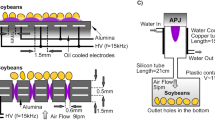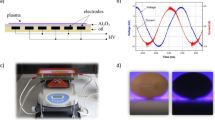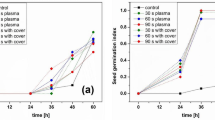Abstract
Seed modification by atmospheric pressure non-thermal plasma treatment was tested on pine species. The Diffuse Coplanar Surface Barrier Discharge (DCSBD) with expose times of 0 s, 1 s, 3 s, 5 s, 10 s, 30 s, 60 s was used on seed treatment of Pinus sylvestris, Pinus nigra and Pinus mugo. The effect of plasma treatment on the chemical bonds on the seed surface was studied using the Attenuated Total Reflectance-Fourier Transform Infrared Spectroscopy (ATR-FTIR). Characteristics of seed germination and early growth were measured. ATR-FTIR surface diagnostics did not show any damage. Changes in the peak intensities indicated the presence of oxygen and nitrogen-containing groups, or a reduction of the lipid layer on the surface. Various statistically significant effects of the three species of seeds treated with DCSBD treatment were recorded. No significant differences were found between control sample and plasma treated ones, but some positive trends were obtained. Positive trends were recorded in germinated and growing seeds of all three species mainly after 3 s exposures. Exposure times from 10 s had an inhibitory effect. Based on the results obtained, it can be recommended that forest nurseries performance of nonthermal plasma modification of seeds should be evaluated to measure the durability of the observed growth characteristics.




Similar content being viewed by others
References
Brandenburg R, Bogaerts A, Bongers W, Fridman A, Fridman G, Locke BR, Miller V, Reuter S, Schiorlin M, Verreycken T, Ostrikov KK (2019) White paper on the future of plasma science in environment, for gas conversion and agriculture. Plasma Process Polym 16:e1700238
Ito M, Oh JS, Ohta T, Shiratani M, Hori M (2018) Current status and future prospects of agricultural applications using atmospheric-pressure plasma technologies. Plasma Process Polym 15:e1700073
Kaushik NK, Ghimire B, Li Y, Adhikari M, Veerana M, Kaushik N, Jha N, Adhikari B, Lee SJ, Masur K, von Woedtke T, Weltmann KD, Choi EH (2019) Biological and medical applications of plasma-activated media, water and solutions. Biol Chem 400:39–62. https://doi.org/10.1515/hsz-2018-0226
Thirumdas R, Kothakota A, Annapure U, Siliveru K, Blundell R, Gatt R, Valdramidis VP (2018) Plasma activated water (PAW): chemistry, physico-chemical properties, applications in food and agriculture. Trends Food Sci Technol 77:21–31. https://doi.org/10.1016/j.tifs.2018.05.007
Šerá B, Šerý M, Gavril B, Gajdová I (2017) Seed germination and early growth responses to seed pre-treatment by non-thermal plasma in hemp cultivars (Cannabis sativa L.). Plasma Chem Plasma Process 37:207–221
Dobrin D, Magureanu M, Mandache NB, Ionita MD (2015) The effect of non-thermal plasma treatment on wheat germination and early growth. Innov Food Sci Emerg Technol 29:255–260. https://doi.org/10.1016/j.ifset.2015.02.006
Park DP, Davis K, Gilani S, Alonzo CA, Dobrynin D, Friedman G, Fridman A, Rabinovich A, Fridman G (2013) Reactive nitrogen species produced in water by non-equilibrium plasma increase plant growth rate and nutritional yield. Curr Appl Phys 13:S19–S29. https://doi.org/10.1016/j.cap.2012.12.019
Puač N, Gherardi M, Shiratani M (2018) Plasma agriculture: a rapidly emerging field. Plasma Process Polym 15:1700174. https://doi.org/10.1002/ppap.201700174
Gavrilova OI, Pitukhin AV, Zhuravleva MV, Gostev KV, Gostev VA (2016) In: 16th international multidisciplinary scientific geoconference-SGEM, Albena, Bulgaria
Pauzaite G, Malakauskiene A, Nauciene Z, Zukiene R, Filatova I, Lyushkevich V, Azarko I, Mildaziene V (2018) Changes in Norway spruce germination and growth induced by pre-sowing seed treatment with cold plasma and electromagnetic field: short-term versus long-term effects. Plasma Process Polym 15:e1700068
Šerá B, Zahoranová A, Bujdáková H, Šerý M (2019) Disinfection from pine seeds contaminated with Fusarium circinatum Nirenberg & O’Donnell using non-thermal plasma treatment. Rom Rep Phys 71:701
Bónová L, Zahoranová A, Kováčik D, Zahoran M, Mičušík M, Černák M (2015) Atmospheric pressure plasma treatment of flat aluminium surface. Appl Surf Sci 331:79–86. https://doi.org/10.1016/j.apsusc.2015.01.030
Homola T, Matoušek J, Kormunda M, Hergelová B, Wu L, Černák M (2012) Activation of poly(ethylene terephthalate) surfaces by atmospheric pressure plasma. Polym Degrad Stab 97:2249–2254. https://doi.org/10.1016/j.polymdegradstab.2012.08.001
Skácelová D, Stupavská M, Sťahel P, Černák M (2014) Modification of (111) and (100) silicon in atmospheric pressure plasma. Appl Surf Sci 312:203–207. https://doi.org/10.1016/j.apsusc.2014.04.196
Homola T, Matoušek J, Kormunda M, Wu LYL, Černák M (2013) Plasma treatment of glass surfaces using diffuse coplanar surface barrier discharge in ambient air. Plasma Chem Plasma Process 33:881–894. https://doi.org/10.1007/s11090-013-9467-3
Černáková L, Kováčik D, Zahoranová A, Černák M, Mazúr M (2005) Surface modification of polypropylene non-woven fabrics by atmospheric-pressure plasma activation followed by acrylic acid grafting. Plasma Chem Plasma Process 25:427–437. https://doi.org/10.1007/s11090-004-3137-4
Odrášková M, Ráhel’ J, Zahoranová A, Tiňo R, Černák M (2008) Plasma activation of wood surface by diffuse coplanar surface barrier discharge. Plasma Chem Plasma Process 28:203–211. https://doi.org/10.1007/s11090-007-9117-8
Černák M, Černáková L, Hudec I, Kováčik D, Zahoranová A (2009) Diffuse coplanar surface barrier discharge and its applications for in-line processing of low-added-value materials. Eur Phys J Appl Phys 47:22806. https://doi.org/10.1051/epjap/2009131
Navrátil Z, Trunec D, Šmíd R, Lazar L (2006) A software for optical emission spectroscopy-problem formulation and application to plasma diagnostics. Czechoslov J Phys 56:944–951. https://doi.org/10.1007/s10582-006-0308-y
Laux CO (2002) In: Fletcher D, Charbonnier M, Sarma GSR, Magin T (eds) von Karman institute lecture series 2002–07, physico-chemical modeling of high enthalpy and plasma flows. Von Karman Institute for Fluid Dynamics, Rhode-Saint-Genèse, Belgium
Švubová R, Kyzek S, Medvecká V, Slovaková L, Gálová E, Zahoranová A (2020) Novel insight at the effect of cold atmospheric pressure plasma on the activity of enzymes essential for the germination of pea (Pisum sativum L. cv. Prophet) seeds. Plasma Chem Plasma Process 40:1221–1240. https://doi.org/10.1007/s11090-020-10089-9
Tomeková J, Kyzek S, Medvecká V, Gálová E, Zahoranová A (2020) Influence of cold atmospheric pressure plasma on pea seeds: DNA damage of seedlings and optical diagnostics of plasma. Plasma Chem Plasma Process. https://doi.org/10.1007/s11090-020-10109-8
Šerý M, Zahoranová A, Kerdík A, Šerá B (2020) Seed germination of black pine (Pinus nigra Arnold) after diffuse coplanar surface barrier discharge plasma treatment. IEEE Trans Plasma Sci 48:939–945. https://doi.org/10.1109/tps.2020.2981600
Christou C, Agapiou A, Kokkinofta R (2018) Use of FTIR spectroscopy and chemometrics for the classification of carobs origin. J Adv Res 10:1–8. https://doi.org/10.1016/j.jare.2017.12.001
Guo Q, Wang Y, Zhang H, Qu G, Wang T, Sun Q, Liang D (2017) Alleviation of adverse effects of drought stress on wheat seed germination using atmospheric dielectric barrier discharge plasma treatment. Sci Rep 7:16680
Pietrzak LN, Miller S (2005) Microchemical structure of soybean seeds revealed in situ by ultraspatially resolved synchrotron Fourier transformed infrared microspectroscopy. J Agric Food Chem 53:9304–9311
Zahoranová A, Hoppanová L, Šimončicová J, Tučeková Z (2018) Effect of cold atmospheric pressure plasma on maize seeds: enhancement of seedlings growth and surface microorganisms inactivation. Plasma Chem Plasma Process 38:969–988. https://doi.org/10.1007/s11090-018-9913-3
Bormashenko E, Grynyov R, Bormashenko Y, Drori E (2012) Cold radiofrequency plasma treatment modifies wettability and germination speed of plant seeds. Sci Rep 2:3–10
Los A, Ziuzina D, Boehm D, Cullen PJ, Bourke P (2019) Investigation of mechanisms, involved in germination enhancement of wheat (Triticum aestivum) by cold plasma: effects on seed surface chemistry and characteristics. Plasma Process Polym 16:e1800148. https://doi.org/10.1002/ppap.201800148
Šerá B, Gajdová I, Šerý M, Špatenka P (2013) New physicochemical treatment method of poppy seeds for agriculture and food industries. Plasma Sci Technol. https://doi.org/10.1088/1009-0630/15/9/19
Šerá B, Gajdová I, Černák M, Gavril B, Hnatiuc E, Kováčik D, Kříha V, Sláma J, Šerý M, Špatenka P (2012) In: Clotea LR, Cernat M (eds) Proceedings of the international conference on optimization of electrical and electronic equipment, Brasov, Romania
Šerá B, Šerý M (2018) Non-thermal plasma treatment as a new biotechnology in relation to seeds, dry fruits, and grains. Plasma Sci Technol 20:044012
Scholtz V, Sera B, Khun J, Sery M, Julak J (2019) Effects of nonthermal plasma on wheat grains and products. J Food Qual. https://doi.org/10.1155/2019/7917825
Shapira Y, Bormashenko E, Drori E (2019) Pre-germination plasma treatment of seeds does not alter cotyledon DNA structure, nor phenotype and phenology of tomato and pepper plants. Biochem Biophys Res Commun 19:512–517
Acknowledgements
This work was supported by the Slovak Research and Development Agency under the Contract No. APVV-16-0216.
Author information
Authors and Affiliations
Corresponding author
Additional information
Publisher's Note
Springer Nature remains neutral with regard to jurisdictional claims in published maps and institutional affiliations.
Rights and permissions
About this article
Cite this article
Šerá, B., Šerý, M., Zahoranová, A. et al. Germination Improvement of Three Pine Species (Pinus) After Diffuse Coplanar Surface Barrier Discharge Plasma Treatment. Plasma Chem Plasma Process 41, 211–226 (2021). https://doi.org/10.1007/s11090-020-10128-5
Received:
Accepted:
Published:
Issue Date:
DOI: https://doi.org/10.1007/s11090-020-10128-5




